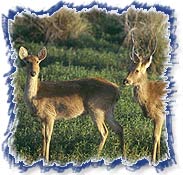Ranthambore National Park

Location : Ranthambore
National Park is situated in Eastern Rajasthan, where the Aravali Hill
ranges and the Vindhyan plateau meet near Sawai Madhopur in Rajasthan.
Best time to visit : During the months of October -
March and April to June.
The Park
Ranthambhore National Park, once the hunting preserve of the Maharajas of
Jaipur is bounded by the rivers - Chambal in the South and Banas in the
North. The prime focus of the park are the six man-made lakes and the
various perennial streams interwining the entire park. The Ranthambore
National Park possesses an internal drainage system with no link up with any
river system inspite of the fact that two rivers bound the Park in it’s
northern and southern side.
The park deriving its name from the 1000 years old fort is the best place
on earth for the wildlife photographers and nature lovers for its
picturesque surroundings, exquisite landscape and rich wildlife. The
Ranthambhore Fort (from which the park derived its name) is one of the most
spectacular and commanding sites amidst the park area. This impressive fort
also houses several sights withins its complex, which are worth visiting.
How to reach :
Air : Jaipur at 145-kms and is the nearest airport from
Ranthambore wildlife sanctuary.
Rail : The park is stationed around 11-kms away from
Sawai Madhopur railway station, which lies on the Delhi to Bombay trunk
route.
Road : A good network of buses connect Sawai Madhopur,
the nearest town from Ranthambore to all the major cities within the state
of Rajasthan.
Wildlife attractions :

The Park covers a small area but has a rich diversity of various species of
fauna and flora which covers 300 trees, 50 aquatic plants, 272 birds, 12
reptiles including the Marsh Crocodile & amphibians and 30 mammals.
The Flora : The park is dominated by old Banyan Trees,
Dhok & Pipal trees, clusters of mango trees. The terrain comprises of
massive rock formations, steep scarps, perennial lakes and streams and
forest giving way to large areas of Savannah. The terrain of the sanctuary
ranges from impregnable dense forests to open bush lands. The prime
vegetation in the forest is the typically dry deciduous type, with Dhok,
being the most common tree.
The Fauna : The Park is known for the wild Tigers and
is a favorite with photographers. Ranthambore wildlife sanctuary has a great
variety of flora and fauna. Tigers, “the pride of the park” makes
it one of the best places in the country to observe them. Besides Tigers, a
large numbers of Sambar, Chital, Nilgai, Gazzelle, Boars, Mongoose, Indian
Hare, Monitor Lizards and a large number of birds can be seen in the park.
Park Trip
Jeep and Elephant safari are the two most ideal ways to explore the rich
wildlife at Ranthambhore.


 The Park covers a small area but has a rich diversity of various species of
fauna and flora which covers 300 trees, 50 aquatic plants, 272 birds, 12
reptiles including the Marsh Crocodile & amphibians and 30 mammals.
The Park covers a small area but has a rich diversity of various species of
fauna and flora which covers 300 trees, 50 aquatic plants, 272 birds, 12
reptiles including the Marsh Crocodile & amphibians and 30 mammals.